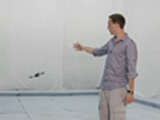|
|
TODAY.AZ / Weird / Interesting
Swiss quadrocopters' flight controlled with hand gestures, via kinect - VIDEO
08 July 2011 [14:10] - TODAY.AZ
 The quadrocopters at ETH Zurich’s Flying Machine Arena already have some amazing autonomous moves. But engineers want to make them easier and more intuitive to control, so they turned to the Kinect.
The quadrocopters at ETH Zurich’s Flying Machine Arena already have some amazing autonomous moves. But engineers want to make them easier and more intuitive to control, so they turned to the Kinect.The Kinect sensor tracks the movements of a person in the arena, monitoring his arms and shoulders. As he raises his arm, the quadrocopter takes off; he can control it by sweeping his right arm around.
A raised left arm tells the quadrocopter to flip; a clap of the hands tells it to land. If the user drops both arms, the quadrocopter will hover. The user is protected by a no-fly zone around him, so the quadrocopter can’t fly into him. A standard controller gives the copter directions, as the video explains.
Other Kinectified drones and quadrocopters use the motion sensor technology to navigate; this one lets the humans do the navigating. Previously, the human controllers at the FMA have used a wand to direct the copters’ flight, but simple arm gestures are more intuitive.
This system is much simpler than other human-machine interfaces we’ve seen — and another great use for the Kinect.
/Popular Science/
Watch video:
URL: http://www.today.az/news/interesting/89911.html
 Print version
Print version
Views: 2374
Connect with us. Get latest news and updates.
See Also
- 19 February 2025 [22:20]
Visa and Mastercard can return to Russia, but with restrictions - 05 February 2025 [19:41]
Japan plans to negotiate with Trump to increase LNG imports from United States - 23 January 2025 [23:20]
Dubai once again named cleanest city in the world - 06 December 2024 [22:20]
Are scented candles harmful to health? - 23 November 2024 [14:11]
Magnitude 4.5 earthquake hits Azerbaijan's Lachin - 20 November 2024 [23:30]
Launch vehicle with prototype of Starship made its sixth test flight - 27 October 2024 [09:00]
Fuel prices expected to rise in Sweden - 24 October 2024 [19:14]
Turkiye strikes terror targets in Iraq and Syria - 23 October 2024 [23:46]
Kazakhstan supplied almost entire volume of oil planned for 2024 to Germany in 9 months - 23 October 2024 [22:17]
Taiwan reported passage of Chinese Navy aircraft carrier near island
Most Popular
 What von der Leyen doesn't know about. Or doesn't want to know
What von der Leyen doesn't know about. Or doesn't want to know
 Turkish auto sector shifts gears for green transformation
Turkish auto sector shifts gears for green transformation
 Bayramov: Direct talks yield better results than mediated dialogue
Bayramov: Direct talks yield better results than mediated dialogue
 Japan grants $3 billion loan to Ukraine using profits from frozen Russian assets
Japan grants $3 billion loan to Ukraine using profits from frozen Russian assets
 Baku spends over 1 billion manats on education in Q1
Baku spends over 1 billion manats on education in Q1
 America’s tariff strategy risks fragmenting global economy
America’s tariff strategy risks fragmenting global economy
 At least 148 dead after boat accident on DR Congo river
At least 148 dead after boat accident on DR Congo river
